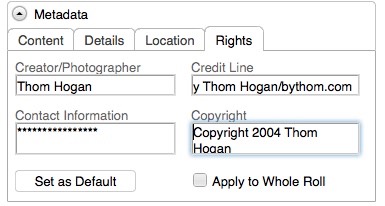(news, commentary, a bit of a review)
source of item: review copy supplied by Meta35
Meta35 is a small USB dongle and cable that you plug into data port of your film SLR, plus a Windows or Macintosh program. In the Nikon world Meta35 supports the N90(s), F100, F5, and F6 models. The Canon 1V is supported. And if you’re an A-mounter, the Minolta Maxxum, Dymax, and Alpha 7 and 9 models all are supported. If you’re interested in what exactly is supported, see here.
A bit of history: the Nikon N90 was the first commercial film SLR I know of that kept shooting information in memory internally, and had a way of getting that out of the camera into a form you could use on your computer. Originally that worked via a Sharp Wizard, but Nikon also created a piece of software called Photo Secretary and produced a 10-pin to Serial cable. All the Nikon prosumer/pro film SLRs after the N90 had the ability, and it formed the genesis upon which the Nikon DSLRs did EXIF, too.
Minolta eventually jumped on this bandwagon, though I’m not sure what software they provided. Canon was also a little late to the game, with the EOS 1V being the only camera they built that had accessible shooting memory.
When the F6 appeared, Nikon built a new accessory, the MV-1, that essentially moved the camera data to a card, and then you could use that card with your card reader and another Nikon program to grab the data in spreadsheet form.
The Meta35 disperses with the intermediary step of a card: you plug the Meta35 into your camera (10-pin port on the Nikons) and your computer (USB port) simultaneously and run their software program to grab data.
Meta35 was released a bit before I expected, so I haven’t gotten the rolls of film back yet I shot to use with this article. Instead, we’ll pull data from when I was reviewing the F6.

Here I’ve performed the first step: data import from camera. Apparently I left data from two shoots in the camera (you have to erase camera memory from time to time as it is finite). The image we’re looking at here was one of a series of focus checks I was doing, which I later digitized into a JPEG with my Nikon slide scanner. At the bottom below the image note the EXIF-like data: this image was shot in Manual exposure mode, 1/250, +0.3EV exposure compensation, f/5, using the matrix meter, ISO 400 film, and the 24-120mm f/3.5-5.6 lens at 24mm:
Note that you can create and attach further metadata to the image with Meta35 (see lower left of main window, shown magnified here):

With some cameras (unfortunately not my F6), you can set custom functions, as well, including being able to load a preset of functions you’ve previously made with a single click):

Meta35 isn’t without a few warts, though these are generally things built into the camera that they had to program around. For instance, on some cameras you have to disconnect the camera when you exit Meta35 (the camera thinks it is still talking to something ;~). As I noted before, you need to be disciplined about erasing the camera’s memory or else you may end up shooting without recording new data.
In general, the Meta35 software is straight forward and prompts you on many of those gotchas that might catch you up. Using Meta35 is a little labor intensive if you’re going to do it right: (1) erase your camera’s memory; (2) go out and shoot; (3) have your film processed, (4) scan the film and place each roll into its own folder; (5) hook the camera to the computer and run the Meta35 software; (6) grab the data from the camera; (7) load your scanned images; and (8) enter any additional metadata you want.
Step 4 is trickier than you think. What you’re really going to want to do there is not only scan, but do a full post processing to create a finished image, I think. Meta35 backs up your images before it embeds the added data, by the way.
So why would you want Meta35?
Well, the classic film SLR problem was this: you’d go out and shoot in the field, then you’d come back and you (a) couldn’t exactly tell what you messed up; and (b) you couldn’t distinguish image 1 with settings 1 from image 2 with settings 2 unless you took copious notes. Moreover, those notes didn’t exactly embed with the images ;~). So a year later and you have a question, you have to figure out which notes apply to which image.
If you’re shooting film for customers or publication, the ability to now tag additional metadata into the scans you might provide them is also useful. Sure, you can do that in Lightroom, but Lightroom doesn’t have the camera shooting information in it, and sometimes (photo publications, for instance), they want the shooting information.
At US$150, Meta35 isn’t cheap. But it’s useful. Indeed, I find it more convenient than Nikon’s MV-1, which costs US$250. Moreover, Meta35’s software is decidedly better than Nikon’s crude program.
